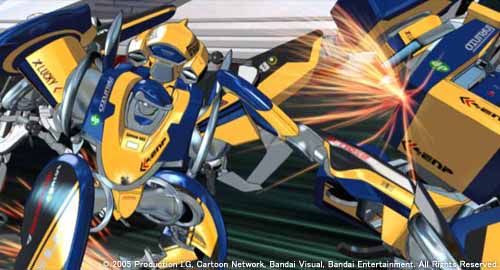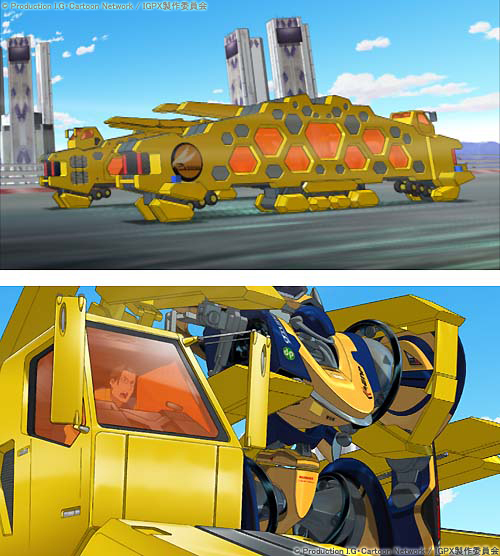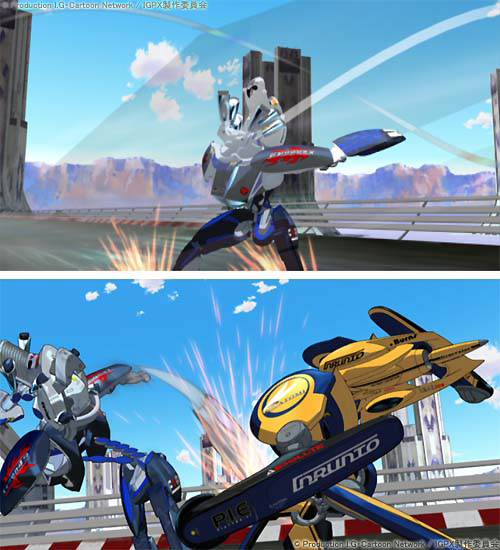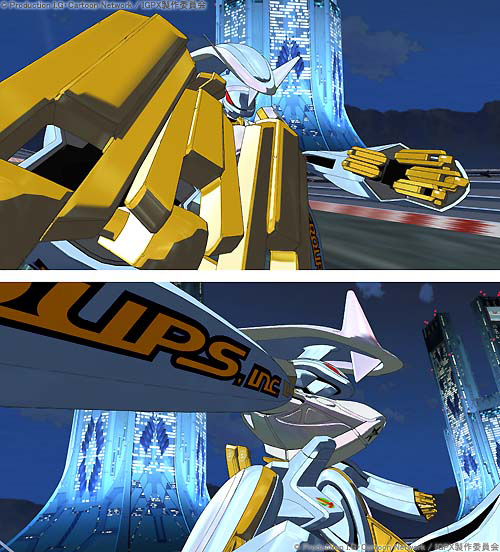The Making of IGPX 3D Animation Step 3: Motion [part 2]

Hyper-dynamic battles between lavishly detailed IG machines running at speed higher than 400 km/h is definitely one of IGPX most impressive characteristics.
For this reason, we decided to get inside Production I.G's 3D Room, and ask the computer graphics team to tell us everything about the creative process behind the astounding mechs of IGPX.
STAFF PROFILE
Miki Yoshida
3DCGI. Yoshida is the leader of the IGPX 3D animation team. His main works include: Blood: The Last Vampire (2000), Kaidohmaru (2001) and Ghost in the Shell: Stand Alone Complex (2002).
Toshio Kawaguchi
3DCGI. Kawaguchi came to I.G bringing his long experience at Sudio Ghibli. He worked in titles such as Laputa - Castle in the Sky (1989), Porco Rosso (1992), Ponpoko (1994), Jin-Roh (2000) and Windy Tales (2004).
Yoshimasa Yamazaki
3DCGI. His main works include Innocence, Sakura Wars: The Movie and FLCL.
Do you have a designated staff member to work on a particular IG machine?
Yoshida: The number of scenes allocated to each one of us is the same, but I pick those who are particularly good in a certain area to do it over and over, so in this sense it's not an equal allotment. Yamazaki-san here modeled the pit machine and created the rig for it, so he is the best choice for the one to move the pit machine. Whenever we have a pit machine, we will most likely ask Yamazaki-san to do it.
Yamazaki-san, could we have your point of view?
Yamazaki: It seems like I have made an impossible rig structure for the pit machines that everyone is having difficulty working with... (lol)
Yoshida: They seem to have increased the number of scenes with pit machine gimmicks as the episodes progress as well.
Yamazaki: I feel privileged to be working on them, but that means I'm prone to getting more challenging feedback from people.
Where do you find difficulty in putting motion?
Yamazaki: The motions are not that difficult. Some machines are constructed in a way that's difficult to see how they move. There'll definitely be some movement deviations in an actual 3D figure, like toy models, for instance.
How are the pit machines supposed to be piloted?
Yoshida: We have a scene where Masa (NOTE: Mark in the English version) is maneuvering one with a manipulator, so it would be maneuvered by crew rather than running on a program. There is a scene where the outcome depends completely on the pit machine crew, and thanks to Masa they make it in time. There is a rule that limits the length of time (NOTE: 3 minutes) that the pit machine could be used during the race. Check Episode 18 where Masa tirelessly fixes the machine and Takeshi barely makes it to the goal on time.
How many can get in the pit machine?
Yamazaki: Two. You can see Masa working most of the time on screen, but in the earlier episodes, you may notice River with him as an assistant.

Do you have any particular literature or material to use as a reference?
Yoshida: I don't really have one. I'd rather have my work checked and modified by someone. That would give me the best feedback for the future. In the case of Liz's machine, which supposedly moves like Chinese martial artists, I did get some material from the directing department. So there are a few cases where you would be given some material in advance. But at the end of the day, I think each one of us relies on his own imagination.
Kawaguchi: I would say it's OK as long as they look compelling and fun.
Yoshida: I think at one time they wanted something like Kill Bill.
Kawaguchi: I think it was decided that Team Sledgemama's ribbon attack was supposed to look like Kill Bill. I think that idea came up quite far along in the project.

Kawaguchi: There wasn't much opportunity to exchange ideas among the entire 3D staff, so the outcome really seemed to reflect the past work that influenced each staff member. For instance, if you use someone who is into action-oriented works, his scenes will reflect that. And the scenes done by someone who likes serious and more authentic works will show movements that have that tendency. We can tell by watching the scenes.
Yamazaki-san worked hard as a specialist to cover the technically challenging sections. He would solidly complete the scenes where machines run the spiral course, and he doesn't take a lot of time either, which would be impossible for me.
Yamazaki: It's just that I created it, so I've already had the mapping.
Kawaguchi: That might be true, but still we can't ask anyone but Yamazaki-san when it comes to the spiral course.
Yoshida: When we work on a new section, it takes longer to perceive and comprehend. It makes such a difference when he finishes in just one day whereas we would take 3 to 4 days.
Did you ever come up against a wall doing new things?
Yamazaki: Well, it happened all the time. I tried to drink a cup of coffee or take a break and think of other things. I have to get away to properly refresh my mood and mind. Even a short break brings about new ideas.
What is the ratio of 3D scenes in IGPX?
Yoshida: More recently it has become maybe 100 out of 300 scenes. I don't think we'd ever had a project with that high a ratio at I.G. Episode 21 had the highest ratio, with about 150 scenes. That amounts to half of all the scenes. That episode was really a hit, though we really had a grueling time with the extra workload.
Is 3D graphics more capable of rendering slower or faster movements?
Yoshida: As a tool, I don't think there is any particular preference. But when I asked someone who is really good at speedy moves to do slower scenes, the result wasn't as good as I had expected. I think he felt uncomfortable doing the slower scenes, so I'd say it all depends on each one of us.
Kawaguchi: In regards to IGPX, there are lots of scenes where 2D and 3D portions are combined, and the 3D portions blend in and look more like the 2D. Actually, the storyboards are drawn exactly the same as the 2D's. We say it's a 3D work, but it feels more like a 2D work.

What do you think of the finished work as a whole, including your own scenes?
Yamazaki: It is fun to see how each one of us showed his individual style. I admire Yoshida-san's distinctive scenes. I can tell they're his work with one glance. I think his personality is reflected in his works.
Yoshida: Although I don't really understand how people can say that watching my work...
Kawaguchi: From my point of view, Yoshida-san learned this trick of layering a 3D structure with 2D images at a very early stage of this project. In this sense, Yoshida-san's supervision of the 3D scenes has been reliable and helpful.
3D is good at recreating scenes that are true to reality. It is amazing how he can calculate this backward from a 2D standpoint. This is very difficult even for 2D animators. I feel that he has created one of the many distinct motion styles seen in IGPX.
© 2005 Production I.G, Cartoon Network, Bandai Visual, Bandai Entertainment. All Rights Reserved.

![WORK LIST[DETAILS]](/contents/works/design/images/left_title.gif)



 terms of use
terms of use